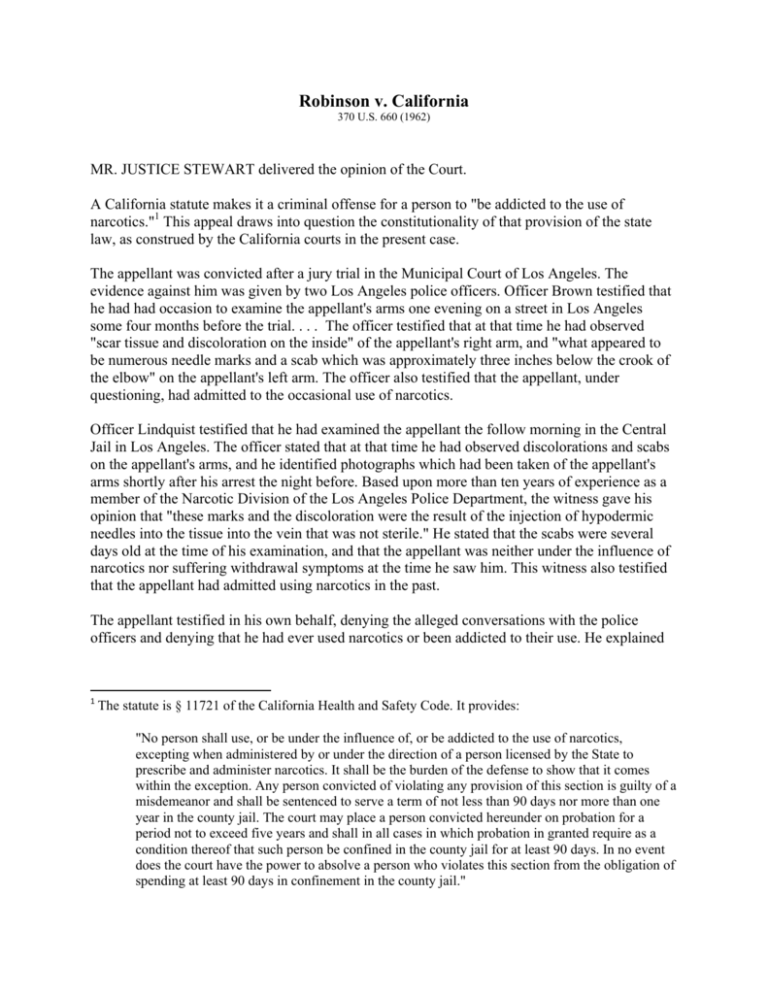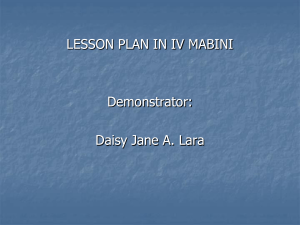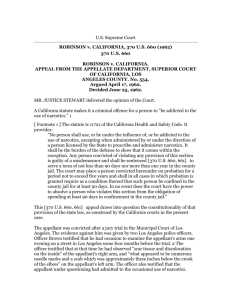Robinson v. California
advertisement

Robinson v. California 370 U.S. 660 (1962) MR. JUSTICE STEWART delivered the opinion of the Court. A California statute makes it a criminal offense for a person to "be addicted to the use of narcotics."1 This appeal draws into question the constitutionality of that provision of the state law, as construed by the California courts in the present case. The appellant was convicted after a jury trial in the Municipal Court of Los Angeles. The evidence against him was given by two Los Angeles police officers. Officer Brown testified that he had had occasion to examine the appellant's arms one evening on a street in Los Angeles some four months before the trial. . . . The officer testified that at that time he had observed "scar tissue and discoloration on the inside" of the appellant's right arm, and "what appeared to be numerous needle marks and a scab which was approximately three inches below the crook of the elbow" on the appellant's left arm. The officer also testified that the appellant, under questioning, had admitted to the occasional use of narcotics. Officer Lindquist testified that he had examined the appellant the follow morning in the Central Jail in Los Angeles. The officer stated that at that time he had observed discolorations and scabs on the appellant's arms, and he identified photographs which had been taken of the appellant's arms shortly after his arrest the night before. Based upon more than ten years of experience as a member of the Narcotic Division of the Los Angeles Police Department, the witness gave his opinion that "these marks and the discoloration were the result of the injection of hypodermic needles into the tissue into the vein that was not sterile." He stated that the scabs were several days old at the time of his examination, and that the appellant was neither under the influence of narcotics nor suffering withdrawal symptoms at the time he saw him. This witness also testified that the appellant had admitted using narcotics in the past. The appellant testified in his own behalf, denying the alleged conversations with the police officers and denying that he had ever used narcotics or been addicted to their use. He explained 1 The statute is § 11721 of the California Health and Safety Code. It provides: "No person shall use, or be under the influence of, or be addicted to the use of narcotics, excepting when administered by or under the direction of a person licensed by the State to prescribe and administer narcotics. It shall be the burden of the defense to show that it comes within the exception. Any person convicted of violating any provision of this section is guilty of a misdemeanor and shall be sentenced to serve a term of not less than 90 days nor more than one year in the county jail. The court may place a person convicted hereunder on probation for a period not to exceed five years and shall in all cases in which probation in granted require as a condition thereof that such person be confined in the county jail for at least 90 days. In no event does the court have the power to absolve a person who violates this section from the obligation of spending at least 90 days in confinement in the county jail." 2 the marks on his arms as resulting from an allergic condition contracted during his military service. His testimony was corroborated by two witnesses. The trial judge instructed the jury that the statute made it a misdemeanor for a person "either to use narcotics, or to be addicted to the use of narcotics. . . . That portion of the statute referring to the 'use' of narcotics is based upon the 'act' of using. That portion of the statute referring to 'addicted to the use' of narcotics is based upon a condition or status. They are not identical. . . . To be addicted to the use of narcotics is said to be a status or condition, and not an act. It is a continuing offense, and differs from most other offenses in the fact that [it] is chronic, rather than acute; that it continues after it is complete, and subjects the offender to arrest at any time before he reforms. The existence of such a chronic condition may be ascertained from a single examination if the characteristic reactions of that condition be found present." The judge further instructed the jury that the appellant could be convicted under a general verdict if the jury agreed either that he was of the "status" or had committed the "act" denounced by the statute. "All that the People must show is either that the defendant did use a narcotic in Los Angeles County, or that, while in the City of Los Angeles, he was addicted to the use of narcotics. . . .” Under these instructions, the jury returned a verdict finding the appellant "guilty of the offense charged." . . . The broad power of a State to regulate the narcotic drugs traffic within its borders is not here in issue. . . . Such regulation, it can be assumed, could take a variety of valid forms. A State might impose criminal sanctions, for example, against the unauthorized manufacture, prescription, sale, purchase, or possession of narcotics within its borders. In the interest of discouraging the violation of such laws, or in the interest of the general health or welfare of its inhabitants, a State might establish a program of compulsory treatment for those addicted to narcotics. Such a program of treatment might require periods of involuntary confinement. And penal sanctions might be imposed for failure to comply with established compulsory treatment procedures. Or a State might choose to attack the evils of narcotics traffic on broader fronts also -- through public health education, for example, or by efforts to ameliorate the economic and social conditions under which those evils might be thought to flourish. In short, the range of valid choice which a State might make in this area is undoubtedly a wide one, and the wisdom of any particular choice within the allowable spectrum is not for us to decide. Upon that premise we turn to the California law in issue here. It would be possible to construe the statute under which the appellant was convicted as one which is operative only upon proof of the actual use of narcotics within the State's jurisdiction. But the California courts have not so construed this law. Although there was evidence in the present case that the appellant had used narcotics in Los Angeles, the jury were instructed that 3 they could convict him even if they disbelieved that evidence. The appellant could be convicted, they were told, if they found simply that the appellant's "status" or "chronic condition" was that of being "addicted to the use of narcotics." And it is impossible to know from the jury's verdict that the defendant was not convicted upon precisely such a finding. . . . This statute, therefore, is not one which punishes a person for the use of narcotics, for their purchase, sale or possession, or for antisocial or disorderly behavior resulting from their administration. It is not a law which even purports to provide or require medical treatment. Rather, we deal with a statute which makes the "status" of narcotic addiction a criminal offense, for which the offender may be prosecuted "at any time before he reforms." California has said that a person can be continuously guilty of this offense, whether or not he has ever used or possessed any narcotics within the State, and whether or not he has been guilty of any antisocial behavior there. It is unlikely that any State at this moment in history would attempt to make it a criminal offense for a person to be mentally ill, or a leper, or to be afflicted with a venereal disease. A State might determine that the general health and welfare require that the victims of these and other human afflictions be dealt with by compulsory treatment, involving quarantine, confinement, or sequestration. But, in the light of contemporary human knowledge, a law which made a criminal offense of such a disease would doubtless be universally thought to be an infliction of cruel and unusual punishment in violation of the Eighth and Fourteenth Amendments. . . . We cannot but consider the statute before us as of the same category. In this Court, counsel for the State recognized that narcotic addiction is an illness. Indeed, it is apparently an illness which may be contracted innocently or involuntarily.2 We hold that a state law which imprisons a person thus afflicted as a criminal, even though he has never touched any narcotic drug within the State or been guilty of any irregular behavior there, inflicts a cruel and unusual punishment in violation of the Fourteenth Amendment. To be sure, imprisonment for ninety days is not, in the abstract, a punishment which is either cruel or unusual. But the question cannot be considered in the abstract. Even one day in prison would be a cruel and unusual punishment for the "crime" of having a common cold. We are not unmindful that the vicious evils of the narcotics traffic have occasioned the grave concern of government. There are, as we have said, countless fronts on which those evils may be legitimately attacked. We deal in this case only with an individual provision of a particularized local law as it has so far been interpreted by the California courts. Reversed. 2 Not only may addiction innocently result from the use of medically prescribed narcotics, but a person may even be a narcotics addict from the moment of his birth. . . .

![[J-56A&B-2014][MO – Eakin, J.] IN THE SUPREME COURT OF](http://s3.studylib.net/store/data/008438149_1-ddd67f54580e54c004e3a347786df2e1-300x300.png)



